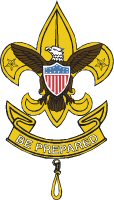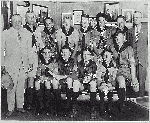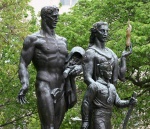Difference between revisions of "Scouts BSA"
Brucejohnson (Talk | contribs) (→Adult leadership) |
Brucejohnson (Talk | contribs) (→Youth leadership) |
||
| Line 43: | Line 43: | ||
==Leadership in the troop== | ==Leadership in the troop== | ||
Every troop has two separate leadership structures: one consisting of Scouts and another consisting of adults.<ref name="trooporg"/> The adult leadership manages the logistics of troop activities, administers rank advancement and awards, maintains troop records and finance, and recruits new Scouts and adult leaders. The youth leadership keeps order and coordinates labor at activities. Scouts and adults cooperate to plan agendas for troop meetings, as well as the troop's schedule of outings. | Every troop has two separate leadership structures: one consisting of Scouts and another consisting of adults.<ref name="trooporg"/> The adult leadership manages the logistics of troop activities, administers rank advancement and awards, maintains troop records and finance, and recruits new Scouts and adult leaders. The youth leadership keeps order and coordinates labor at activities. Scouts and adults cooperate to plan agendas for troop meetings, as well as the troop's schedule of outings. | ||
| − | |||
| − | |||
| − | |||
| − | |||
| − | |||
| − | |||
===Development=== | ===Development=== | ||
Revision as of 15:10, 22 July 2009
| Boy Scouting is a membership level of the Boy Scouts of America (BSA) for boys and young men. It provides effective youth training in character, citizenship, and mental and personal fitness. Boy Scouts are expected to develop personal religious values, learn the principles of American heritage and government, and acquire skills to become successful adults.
|| ||
To achieve these, Boy Scouting applies eight methods of Scouting: Ideals (viz., the Scout Oath, the Scout Law, the Scout Motto, and the Scout Slogan), the patrol method, participation in outdoor programs, advancement, adult association, personal growth, leadership development, and the uniform. Boy Scouting is generally available to boys between the ages of eleven and seventeen. They are organized in Scout troops, administered by volunteers with support of paid professional staff. Youth and adult members are Scouts, the boys are referred to as Boy Scouts, and the adults as Scouters. |
Program and activities
The troop program and activities are determined by the senior patrol leader and the patrol leaders council under the oversight of the Scoutmaster. Troops generally hold meetings weekly, although they can be irregular during the summer. Troop meeting activities may vary from training in Scout skills to planning camping trips or playing games.
Troops may plan outings and activities outside the troop meeting. These may involve camping, backpacking, hiking, canoeing, rafting, climbing, caving, rappelling, and other activities. These outings are an important place for Scouts to work on skills and rank advancement, have fun, and engage in productive outdoor activities.
Most councils own and operate one or more permanent camps. These camps may host a variety of activities throughout the year. The summer camp program provides a week-long session for troops that includes merit badge advancement and adventure activities. Facilities may include ranges for shooting sports — archery, rifle, and shotgun — and for climbing and rappelling.
It is common for several troops within a district or council to gather at least once a year at a special weekend campout called a amporee. A camporee is a district- or council-wide event where several units camp and engage in activities, Scoutcraft competitions and learn specialized skills.
The national Scout jamboree usually occurs every four years, and draws more than 30,000 Scouts from across the country and the world. The last jamboree took place in 2005 at Fort A.P. Hill in Virginia, and the next will occur in 2010, celebrating the BSA's centennial.
Ideals
The Scout Law, Scout Oath, Scout Motto, Scout Slogan, and Outdoor Code are the cornerstones of Boy Scouting. Each Scout learns to use make these ideals a part of their way of life and personal growth. Boy Scouts must memorize and understand these ideals. They also represent these ideals symbolically in official emblems.
The Scout Sign is used when giving the Scout Law or the Scout Oath and as a signal for silence. The Scout Salute is used when saluting the flag of the United States. The left-handed handshake is used as a token of friendship and as an identity with Scouts worldwide.
Advancement and recognition
Youth advancement
Boy Scouts has seven ranks, grouped into two phases. The first phase of Scout, Tenderfoot, Second Class, and First Class is designed to teach the boy Scoutcraft skills, teamwork, and self-reliance. Scout is the first rank, awarded when a boy first joins the Scouts, and requires just a rudimentary knowledge of Scouting's ideals. Further ranks have progressive requirements in the areas of Scoutcraft, physical fitness, citizenship, personal growth, and Scout Spirit. Scouts with a permanent mental or physical disability may use alternate requirements, based on their abilities and approved by the council.
The second phase of Star, Life, and Eagle is designed to develop leadership skills and encourage the Scout to explore potential vocations and avocations through the merit badge program. These ranks require that the boy serve in a position of responsibility and perform community service.
The Eagle Scout requires, in addition to merit badges and a position of responsibility, a community service project planned and led entirely by the Eagle Scout candidate. After attaining the rank of Eagle, a Scout may earn Eagle Palms for additional tenure and merit badges.
Although Eagle is the highest rank, for which Scouts should strive, the number of Scouts achieving First Class within one year of joining is still one of the key measures of unit effectiveness. Studies have shown that if a Scout achieves First Class within a year of joining, he typically stays in Scouting for at least three years. Scouts who do so are more likely to retain Scout values as an adult and achieve the BSA primary mission of "producing useful citizens".
Ranks and other recognitions are presented in a troop awards ceremony called the court of honor. The Eagle Scout rank is usually presented in a separate and special court of honor.
Awards
Several religious emblems programs are administered by various religious institutions and recognized by the BSA. These are generally recognized by a medal and an embroidered square knot. Other advancement and recognitions—such as the Mile Swim Award, Crime Prevention Awards, Emergency Preparedness Award and World Conservation Award—are available to Scouts who show proficiency in special areas. BSA's National Court of Honor is responsible for lifesaving and meritorious awards. All Courts of Honor for Eagle Scout rank are convened as National Courts of Honor also.
Leadership in the troop
Every troop has two separate leadership structures: one consisting of Scouts and another consisting of adults.<ref name="trooporg"/> The adult leadership manages the logistics of troop activities, administers rank advancement and awards, maintains troop records and finance, and recruits new Scouts and adult leaders. The youth leadership keeps order and coordinates labor at activities. Scouts and adults cooperate to plan agendas for troop meetings, as well as the troop's schedule of outings.
Development
The Scoutmaster provides Troop Leadership Training (TLT) at the troop level. Youth leaders are encouraged to attend National Youth Leadership Training (NYLT) at the council level and a select few may progress to National Advanced Youth Leadership Experience (NAYLE) at the national level.<ref>Template:Cite web</ref> Those interested in staffing these courses may complete the Youth Staff Development Course (YSDC) at the regional level.
New adult leaders are encouraged to attend training for their position.<ref>Template:Cite web</ref> This training provides the essential information they need to provide a safe and successful quality program. Fast Start Training is the introduction for adult leaders new to the Boy Scout program; it is self pace and provided as a video or online.<ref name="OLC">Template:Cite web</ref> New Leader Essentials is common core training for adult leaders in the and gives an overview of the Scouting.
Youth Protection Training (YPT) covers the BSA policies on child abuse, including types and signs of abuse, how to respond to disclosed abuse and how to report suspected abuse. Units are required to have adults who are YPT certified and responsible for training youth. YPT recertification intervals are determined by the local council policy.<ref name="OLC" /> At least one person with current YPT certification must be preset on outings.
Scoutmasters and assistants should then attend Scoutmaster and Assistant Scoutmaster Specific Training and Introduction to Outdoor Leader Skills for further instruction in Scouting and outdoor skills. This completes Basic Leader Training for these positions and the Trained emblem may be worn. The troop committee chairman and members should attend the Troop Committee Challenge for instruction in administering the program.<ref name="OLC" /> This completes Basic Leader Training for these positions and the Trained emblem may be worn.
Supplemental training modules are designed to provide orientation beyond Basic Leader Training. These shorter training sessions are often provided at the Roundtable, a monthly meeting of leaders from the district, at a University of Scouting offered by the local councils, and at National Training Conferences held at the Philmont Training Center and the Florida National High Adventure Sea Base.<ref name="OLC" />
At least one leader with current Safe Swim Defense training is required for swimming activities. Boating activities require Safety Afloat and CPR training. Climb On Safely training and CPR certification are required for climbing and rappelling events.
Wood Badge is advanced training for leadership skills for adults in the BSA. Wood Badge consists of six days of training (usually presented as two three-day weekends) and an application phase of several months. When training is complete, leaders are recognized with the Wood Badge beads, neckerchief, and woggle. Powder Horn is a high adventure resource course designed to help Scout leaders to safely conduct outdoor activities of a fun and challenging nature, provide an introduction to the resources necessary to successfully lead their youth through a program of high adventure and to understand what is involved in different high adventure disciplines.
External links
- MeritBadge.Org - Wikipedia that provides resources to Scouts and leaders in the US.
- Merit Badge Worksheets including blank maps, logs, chart, diagrams, and checklists, as needed.


